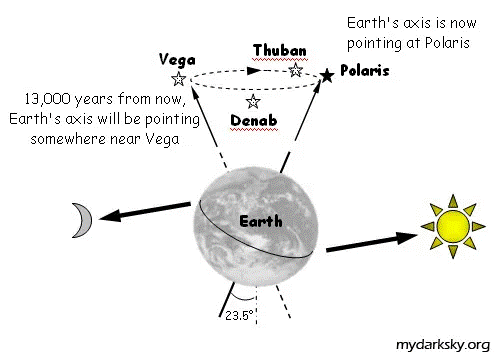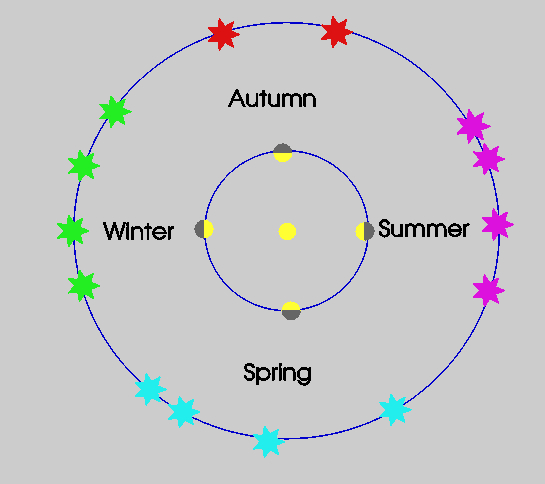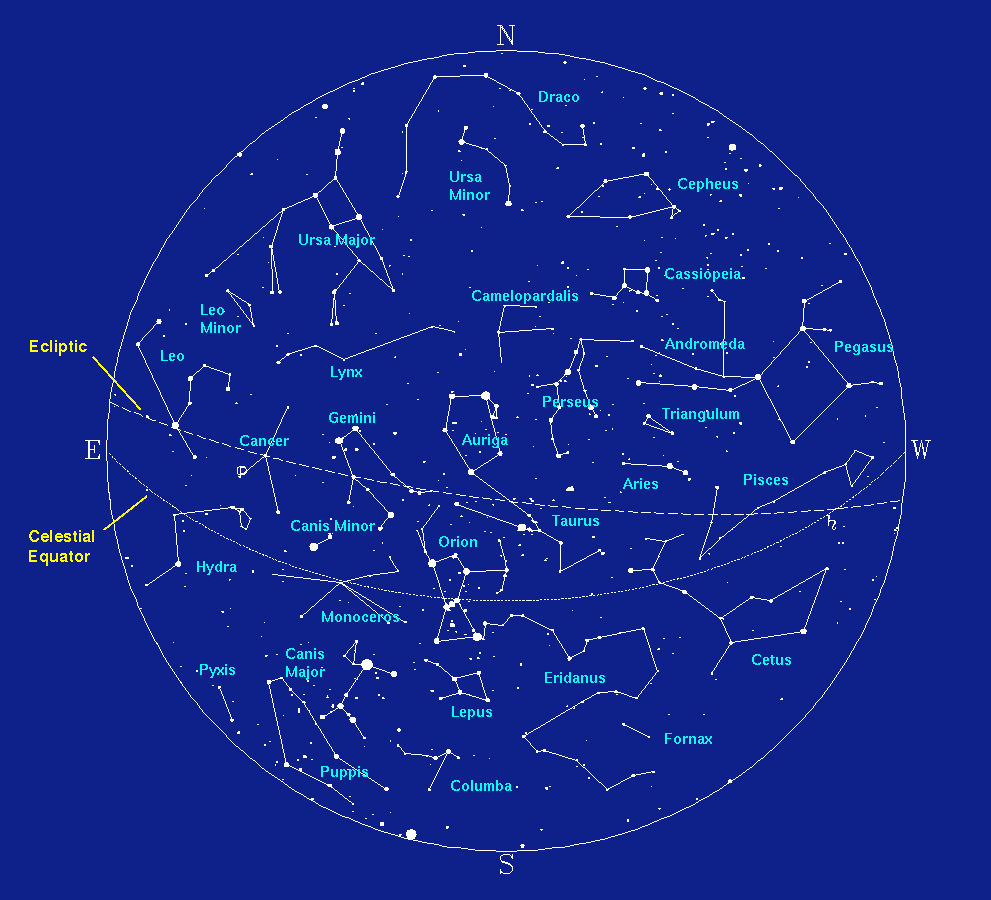Precession is something which happens very slowly, so you will not notice it during your lifetime unless you are taking very accurate measurements of the positions of the stars for several years at a time. So if you just like looking at the Night Sky you can ignore this Page. But the Ancient Astronomers named many of the things they saw in the sky as they saw them, thousands of years ago, and some of these names are still being used today, so knowing something about how precession has changed our view of the sky may help us to understand these names.
The asteroids are rocky bodies, ranging in diameter from less than a metre to nearly a thousand kilometres, circling the Sun in the Asteroid Belt, between Mars and Jupiter. They are just tumbling around in space.
But the Earth, and the Moon and the other planets and their moons, are not tumbling around in space, they are spinning on an axis through them, like a gyroscope, and this prevents them from tumbling.Here is a toy gyroscope inside the ISS.
This spinning motion of the Earth on its axis, without tumbling, is what gives us our days and nights and seasons and tides and weather patterns and lots of other things in a totally regular way, and this in turn is what makes all life on this planet possible.
Gyroscopes and tops and diabolos and lots of other spinning things make wonderful toys, but spinning objects also have serious uses in science and engineering - including on the ISS!
The maths and science behind this behaviour of spinning objects is well beyond Sam and his friends, but it does mean that if anything other than a perfect sphere is spinning on its axis, the axis itself may also move in a circle. This is called precession.
Thanks Iacopo Simonelli. You do not have to watch the video for more than a few seconds to get the idea of precession - and you can turn the sound off!
The Earth is not a perfect sphere - it bulges slightly at the Equator - and so the gravity of the Sun and Moon act on it unequally and its axis of rotation is tilted at about 23½ degrees and it precesses at about one revolution every 26 000 years.

The point in the sky exactly above the Terrestial North Pole is called the Celestial North Pole. At present a star called Polaris is very close to the Celestial North Pole, hence Polaris is also called the Pole Star. For people living North of the Equator all the stars appear to rotate round it as the Earth rotates on its axis. It is always almost exactly due North, so for at least a thousand years before SatNav was invented sailors could use it to find North when making long sea journeys out of sight of land. But because of precession it has not always been like this, and in 3000 BCE the bright star closest to the Celestial North Pole was Thuban.
There is no bright star close to the Celestial South Pole, either now or at any time in the past or future, but the Ancient Polynesians managed to navigate by the stars over thousands of kilometres of ocean without a Southern equivalent of Polaris - in fact they used the same word for navigator and astronomer!
Precession does not in any way affect the way we see the Sun or the Moon or the planets or the stars and constellations. But as the Earth goes round the Sun we can only see the constellations which are on the opposite side of the Earth to the Sun - the sky is much too bright to see the stars during the day! This is more fully explained on another Page.

This means that every star except a circumpolar star has a few weeks each year when it cannot be seen: the Ancient Astronomers thought it had died and gone into the Underworld. The first time it became visible again was a very special day.
This is why the circumpolar stars were special: they never drowned themselves in the Sea or went into the Earth.
Precession means that the constellations which we see in the Spring today are the ones we shall see in the Autumn in thirteen thousand years time, and the ones that the Ancient Egyptians saw in the Summer more than six thousand years ago were not the ones that the Ancient Greeks saw in the summer three thousand years later. So precession gradually changes the day on which a star reappears after its period of invisibility.
The Ancient Egyptians were the first people to discover precession, and this is described on the Page on the Egyptian Calendar. But they did not have the mathematical skills to measure it. But they did make and leave behind stunningly accurate measurements of the positions of the stars for more than a thousand years, and more than three thousand years later the Greek mathematician Hipparchus (about 190 - 120 BCE) used these measurements, together with his own, to measure precession.
He did this by measuring the precession of the equinox. As the Earth goes round the Sun it moves through the different constellations which lie on the ecliptic - this is explained more fully on another Page.
The equinoxes (from the Latin for equal night) are the times when the Sun is exactly over the Equator, so the length of the day is almost exactly equal to the length of the night, everywhere in the world. There are two each year, one, when the Sun is exactly over the Equator and moving North, marks the beginning of Spring, (the words in bold refer to the Northern hemisphere, they are of course reversed for people living in the Southern Hemisphere) and the other, when it is exactly over the Equator but moving South, marks the start of Autumn. On this Chart of the Night Sky the Spring Equinox is where the ecliptic crosses the Celestial Equator. This point is very special and is called The First Point of Aries, because at the time of Hipparchus it was where the Sun first entered Aries. It has its own special symbol. There is another point where the Ecliptic crosses the Celestial Equator, this is the Autumn Equinox and would be on the other side if this map. Hipparchus used his own measurements, and the measurements of the earlier astronomers going right back to the Ancient Egyptians, to show that because of precession the position of the First Point of Aries was moving Westwards at “more than one degree every hundred years.” Today’s value is 360° in 26 000 years, or 1.4° every hundred years, so he was not far off. Today the First Point of Aries is in Pisces.
After the Spring equinox the Sun moves North until it reaches the Summer Solstice. At the time of Hipparcus the Sun was in Cancer at this time so this point marks the Tropic of Cancer. The Summer Solstice always falls on Midsummer’s Day but it is wrong to say that Midsummer's Day is the Summer solstice, the Equinoxes and Solstices are moments in time not days of the year. Our word solstice comes from the Latin for Sun standing still because for several days on each side of it the length of the day changes by only a few seconds a day - Sam shows this to his friends using an App on his iPad. Then the Sun starts to move South again to the Autumn Equinox and the Tropic of Capricorn which marks the position of the Sun at the Winter solstice.
Because of precession the “planetary aspects” in your horoscope in a newspaper are totally unrelated to the real positions of the Sun, Moon and Planets today. Astrology in the 21st century CE is discussed on its own Page.© Barry Gray July 2022